3.0: Obtuse Angles
( \newcommand{\kernel}{\mathrm{null}\,}\)
The town of Avery lies 48 miles due east of Baker, and Clio is 34 miles from Baker, in the direction 35∘ west of north. How far is it from Avery to Clio?
We know how to solve right triangles using the trigonometric ratios. But the triangle formed by the three towns is not a right triangle, because it includes an obtuse angle of 125∘ at B, as shown in the figure.

A triangle that is not a right triangle is called an oblique triangle. In this chapter we learn how to solve oblique triangles using the laws of sines and cosines. But first we must be able to find the sine, cosine, and tangent ratios for obtuse angles.
Angles in Standard Position
To extend our definition of the trigonometric ratios to obtuse angles, we use a Cartesian coordinate system. We put an angle θ in standard position as follows:
- Place the vertex at the origin with the initial side on the positive x-axis;
- the terminal side opens in the counter-clockwise direction.
- We choose a point P on the terminal side of the angle, and form a right triangle by drawing a vertical line from P to the x-axis.
The length of the side adjacent to θ is the x-coordinate of point P, and the length of the side opposite is the y-coordinate of P. The length of the hypotenuse is the distance from the origin to P, which we call r. With this notation, our definitions of the trigonometric ratios are as follows.

- cosθ=xr
- sinθ=yr
- tanθ=yx
It doesn't matter which point P on the terminal side we use to calculate the trig ratios. If we choose some other point, say P′, with coordinates (x′,y′), as shown at right, we will get the same values for the sine, cosine and tangent of θ. The new triangle formed is similar to the first one, so the ratios of the sides of the new triangle are equal to the corresponding ratios in the first triangle.

Find the values of cosθ,sinθ, and tanθ if the point (12,5) is on the terminal side of θ.
- Answer
-
For the point P(12,5), we have x=12 and y=5. We use the distance formula to find r.
r=√(2−0)2+(5−0)2=√25+144=√169=13
The trig ratios are

cosθ=xr=1213sinθ=yr=513tanθ=yx=512
Note 3.2 In the previous example, we get the same results by using the triangle definitions of the trig ratios. We create a right triangle by dropping a vertical line from P to the x-axis, as shown in the figure. The legs of the right triangle have lengths 12 and 5, and the hypotenuse has length 13.
a Find the equation of the terminal side of the angle in the previous example. (Hint: The terminal side lies on a line that goes through the origin and the point (12,5).
b Show that the point P′(24,10) also lies on the terminal side of the angle.
c Compute the trig ratios for θ using the point P′ instead of P.
- Answer
-
a y=512x
b (24,10) satisfies y=512x, that is, the equation 10=512(24) is true.
c r2=242+102=676, so r=√676=26. Then cosθ=xr=2426=1213,sinθ=yr=1026=513, and tanθ=yx=1024=512.
An obtuse angle has measure between 90∘ and 180∘. In this section we will define the trigonometric ratios of an obtuse angle as follows.
- Place the angle θ in standard position and choose a point P with coordinates (x,y) on the terminal side.
- The distance from the origin to P is √x2+y2.
- The trigonometric ratios of θ are defined as follows.
The Trigonometric Ratios:
sinθ=yrcosθ=xrtanθ=yx

1 Draw an angle θ in standard position with the point P(6,4) on its terminal side.
2 Find r, the distance from the origin to P.
3 Calculate sinθ,cosθ, and tanθ. Give both exact answers and decimal approximations rounded to four places.
4 Use the inverse cosine key on your calculator to find θ. Use your calculator to verify the values of sinθ,cosθ, and tanθ that you found in part (3).
5 Draw another angle ϕ in standard position with the point Q(−6,4) on its terminal side. Explain why ϕ is the supplement of θ. (Hint: Consider the right triangles formed by drawing vertical lines from P and Q.
6 Can you use the right triangle definitions (using opposite, adjacent and hypotenuse) to compute the sine and cosine of ϕ? Why or why not?
7 Calculate sinϕ,cosϕ, and tanϕ using the extended definitions listed above. How are the trig values of ϕ related to the trig values of θ?
8 Explain why θ and ϕ have the same sine but different cosines.
9 Use the inverse cosine key on your calculator to find ϕ. Use your calculator to verify the values of sinϕ,cosϕ, and tanϕ that you found in part (7).
10 Compute 180∘−ϕ. What answer should you expect to get?
Trigonometric Ratios for Obtuse Angles
Our new definitions for the trig ratios work just as well for obtuse angles, even though θ is not technically "inside" a triangle, because we use the coordinates of P instead of the sides of a triangle to compute the ratios.
Notice first of all that because x-coordinates are negative in the second quadrant, the cosine and tangent ratios are both negative for obtuse angles. For example, in the figure below, the point (−4,3) lies on the terminal side of the angle θ. We see that r=√(−4)2+32=5, so

cosθ=xr=−45sinθ=yr=35tanθ=yx=3−4=−34
Find the values of cosθ and tanθ if θ is an obtuse angle with sinθ=13.
- Answer
-
Because θ is obtuse, the terminal side of the angle lies in the second quadrant, as shown in the figure below. Because sinθ=13, we know that yr=13, so we can choose a point P with y=1 and r=3. To find cosθ and tanθ we need to know the value of x. From the Pythagorean Theorem,

x2+12=32x2=32−12=8x=−√8
Remember that x is negative in the second quadrant! Thus
cosθ=xr=−√83 and tanθ=yx=−1√8
a Sketch an obtuse angle θ whose cosine is −817.
b Find the sine and the tangent of θ.
- Answer
-
a

b sinθ=1517,tanθ=−158
Using a Calculator
In the examples above, we used a point on the terminal side to find exact values for the trigonometric ratios of obtuse angles. Scientific and graphing calculators are programmed with approximations for these trig ratios.
Find the sine and cosine of 130∘. Compare to the sine and cosine of 50∘.
- Answer
-
Using a calculator and rounding the values to four places, we find
sin130∘=0.7660 and cos130∘=−0.6428
sin50∘=0.7660 and cos50∘=0.6428
We see that sin130∘=sin50∘ and cos130∘=−cos50∘. This result should not be surprising when we look at both angles in standard position, as shown below.

The angles 50∘ and 130∘ are supplementary. The right triangles formed by choosing the points (x,y) and (−x,y) on their terminal sides are congruent triangles.
Consequently, the trigonometric ratios for 50∘ and for 130∘ are equal, except that the cosine of 130∘ is negative.
Use your calculator to fill in the table. Round to four decimal places.
θcosθsinθ180∘−θcos(180∘−θ)sin(180∘−θ)10∘20∘30∘40∘50∘60∘70∘80∘
- Answer
-
θcosθsinθ180∘−θcos(180∘−θ)sin(180∘−θ)10∘0.98480.1736170∘−0.98480.173620∘0.93970.3420160∘−0.93970.342030∘0.86600.5150∘0.8660−0.540∘0.76600.6428140∘−0.76600.642850∘0.64280.7660130∘−0.64280.766060∘0.50.8660120∘−0.50.866070∘0.34200.9397110∘−0.93970.342080∘0.17360.9848100∘−0.98480.1736
Trigonometric Ratios for Supplementary Angles
The examples above illustrate the following equations for supplementary angles. These three equations are called identities, which means that they are true for all values of the variable θ.
- cos(180∘−θ)=−cosθ
- sin(180∘−θ)=sinθ
- tan(180∘−θ)=−tanθ
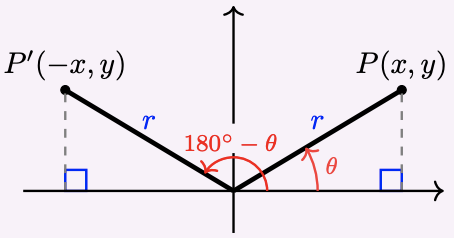
Because of these relationships, there are always two (supplementary) angles between 0∘ and 180∘ that have the same sine. Your calculator will only tell you one of them, so you have to be able to find the other one on your own! Fortunately, this is not difficult.
Find two different angles θ, rounded to the nearest 0.1∘, that satisfy sinθ=0.25.
- Answer
-
To find an angle with sinθ=0.25, we calculate θ=sin−1(0.25). With the calculator in degree mode, we press

to find that one angle is θ≈14.5∘. We draw this acute angle in standard position in the first quadrant, and sketch in a right triangle as shown below. There must also be an obtuse angle whose sine is 0.25. To see the second angle, we draw a congruent triangle in the second quadrant as shown.

The supplement of 14.5∘, namely θ=180∘−14.5∘=165.5∘, is the obtuse angle we need. Notice that yr=0.25 for both triangles, so sinθ=0.25 for both angles.
Find two different angles θ that satisfy sinθ=0.5.
- Answer
-
θ=30∘,θ=150∘
Because there are two angles with the same sine, it is easier to find an obtuse angle if we know its cosine instead of its sine.
Find the angle shown below.

- Answer
-
Using x=−3 and y=4, we find
r=√32+42=√25=5
so cosθ=xr=−35, and θ=cos−1(−35). We can enter
2nd COS−3/5) ENTER
to see that θ≈126.9∘.
In the previous example, you might notice that tanθ=−43 and try to find by calculating tan−1(−43). However, if we press

the calculator returns an angle of θ≈−53.1∘. It is true that tan(−53.1∘)=−43, but this is not the obtuse angle we want.

We also know that sinθ=45, and if we press

we get θ≈53.1∘.
This is the acute angle whose terminal side passes through the point (3,4), as shown in the figure above. The angle we want is its supplement, θ≈180∘−53.1∘=126.9∘.
a Find the cosine of an obtuse angle with tanθ=−2.
b Find the angle θ in part (a).
- Answer
-
a −1√5
b θ≈116.565∘
Supplements of the Special Angles
In Chapter 2 we learned that the angles 30∘,45∘ and 60∘ are useful because we can find exact values for their trigonometric ratios. The same is true for the supplements of these angles in the second quadrant, shown below.

Find exact values for the trigonometric ratios of 135∘.
- Answer
-
We sketch an angle of θ=135∘ in standard position, as shown below. The terminal side is in the second quadrant and makes an acute angle of 45∘ with the negative x-axis, and passes through the point (−1,1). Thus, r=√(−1)2+12=√2, and we calculate

cos135∘=xr=−1√2sin135∘=yr=1√2tan135∘=yx=1−1=−1
Find exact values for the trigonometric ratios of 120∘ and 150∘.
- Answer
-
θcosθsinθtanθ120∘−12√32−√3150∘−√3212−1√3
We can also find the trig ratios for the quadrantal angles. These are the angles, including 0∘, 90∘ and 180∘, whose terminal sides lie on one of the axes.
Find exact values for the trigonometric ratios of 90∘.
- Answer
-
The terminal side of a 90∘ angle in standard position is the positive y-axis. If we take the point P(0,1) on the terminal side as shown at right, then x=0 and y=1. Although we don't have a triangle, we can still calculate a value for r, the distance from the origin to P.

r=√02+12=1
Our coordinate definitions for the trig ratios give us
cos90∘=xr=01 and sin90∘=yr=11
so cos90∘=0 and sin90∘=1. Also, tan90∘=yx=10, so tan 90∘ is undefined.
Find exact values for the trigonometric ratios of 180∘.
- Answer
-
cos180∘=−1,sin180∘=0,tan180∘=0
The Area of a Triangle
The figure below shows part of the map for a new housing development, Pacific Shores. You are interested in the corner lot, number 86, and you would like to know the area of the lot in square feet. The sales representative for Pacific Shores provides you with the dimensions of the lot, but you don’t know a formula for the area of an irregularly shaped quadrilateral.
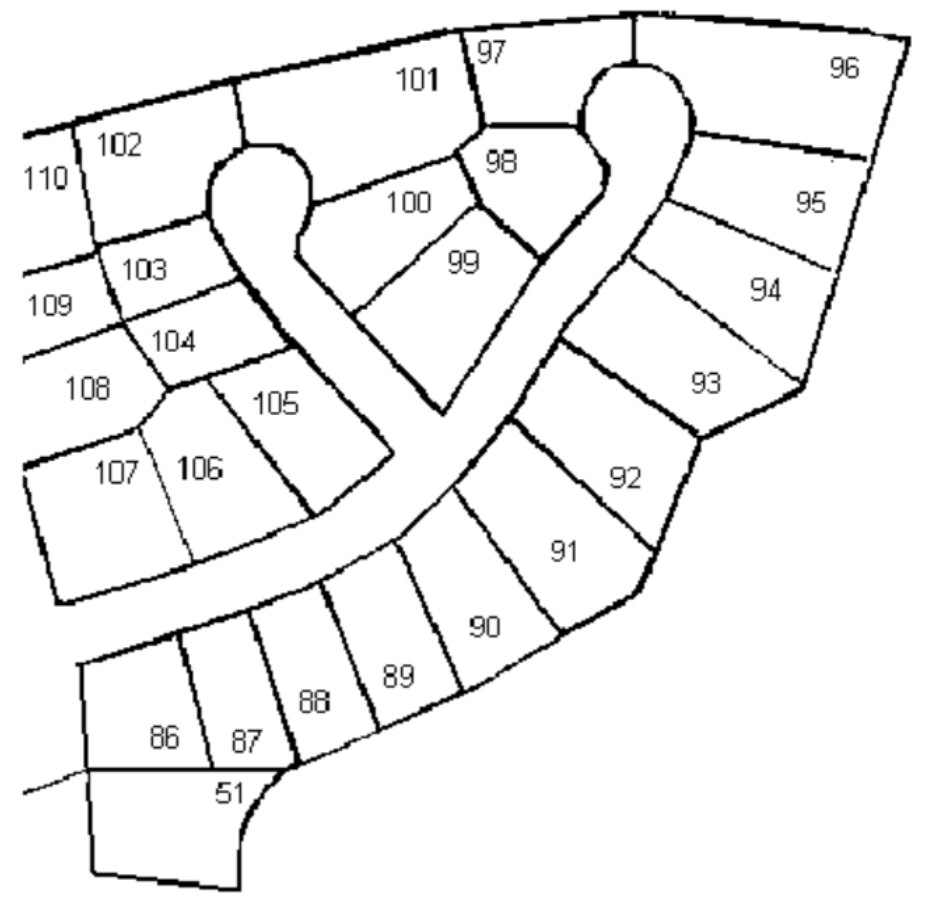
It occurs to you that you can divide the quadrilateral into two triangles, and find the area of each. Now, you know a formula for the area of a triangle in terms of its base and height, namely,

A=12bh,
but unfortunately, you don’t know the height of either triangle.
However, you can easily measure the angles at the corners of the lot using the plot map and a protractor. You can check the values on the plot map for lot 86 shown above.
Using trigonometry, we can find the area of a triangle if we know two of its sides, say a and b, and the included angle, θ. The figure below shows three possibilities, depending on whether the angle θ is acute, obtuse, or 90∘.

In each case, b is the base of the triangle, and its altitude is h. Our task is to find an expression for h in terms of the quantities we know: a,b, and θ. You should check that in all three triangles
sinθ=ha
Solving for h gives us h=asinθ. Finally, we substitute this expression for h into our old formula for the area to get
A=12bh=12basinθ
Area of a Triangle.
If a triangle has sides of length a and b, and the angle between those two sides is θ, then the area of the triangle is given by
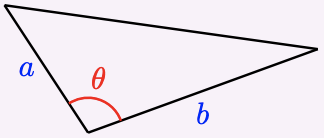
A=12absinθ
Find the area of lot 86.
- Answer
-
For the triangle in the lower portion of lot 86,a=120.3,b=141, and θ=95∘. The area of that portion is
First Area =12absinθ=12(120.3)((141)sin95∘≈8448.88
For the triangle in the upper portion of the lot, a=161,b=114.8, and θ=86.1∘. The area of that portion is
Second Area =12absinθ=12(161)((114.8)sin86.1∘≈9220.00
The total area of the lot is the sum of the areas of the triangles
Total area = First Area + Second Area ≈17668.88
Lot 86 has an area of approximately 17,669 square feet.
The formula A=12absinθ does not mean that we always use the sides labeled a and b to find the area of a triangle.

In this formula, the variables a and b represent the lengths of the sides that include the known angle. For example, the area of the triangle above is given by A=12(5c)sinϕ.
A triangle has sides of length 6 and 7, and the angle between those sides is 150∘. Find the area of the triangle.
- Answer
-
212
Review the following skills you will need for this section
Find the area of the triangle.
1. 
2. 
3. 
4. 
How many degrees are in each fraction of one complete revolution?
5. 14
6. 15
7. 16
8. 18
- Algebra Refresher Answers
-
1. 24
2. 24
3. 24
4. 24
5. 90∘
6. 72∘
7. 60∘
8. 45∘
Section 3.1 Summary
Vocabulary
• Standard position
• Initial side
• Terminal side
• Quadrantal angle
• Oblique triangle
• Quadrilateral
• Identity
Concepts
1 We put an angle in standard position by placing its vertex at the origin and the initial side on the positive x-axis.
2
- cosθ=xr
- sinθ=yr
- tanθ=yx

3
- cos(180∘−θ)=−cosθ
- sin(180∘−θ)=sinθ
- tan(180∘−θ)=−tanθ

4 There are always two (supplementary) angles between 0∘ and 180∘ that have the same sine. Your calculator will only tell you one of them.
5 If a triangle has sides of length a and b, and the angle between those two sides is θ, then the area of the triangle is given by
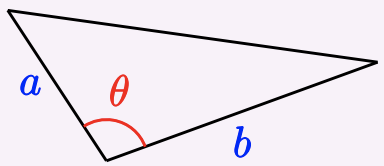
A=12absinθ
Study Questions
1 Delbert says that sinθ=47 in the figure. Is he correct? Why or why not?

2 Give the lengths of the legs of each right triangle.
a 
b 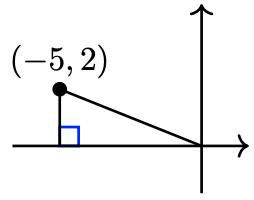
3 Explain why the length of the horizontal leg of the right triangle is −x.

4 Why are the sines of supplementary angles equal, but the cosines are not? What about the tangents of supplementary angles?
5 Use your calculator to evaluate sin118∘, then evaluate sin−1 ANS . Explain the result.
6 Write an expression for the area of the triangle.

Skills
Practice each skill in the Homework Problems listed
1 Use the coordinate definition of the trig ratios #3-20, 45-48
2 Find the trig ratios of supplementary angles #7-10, 21-38
3 Know the trig ratios of the special angles in the second quadrant #21, 41-44
4 Find two solutions of the equation sinθ=k #29-38
5 Find the area of a triangle #49-58
Homework 3.1
1. Without using pencil and paper or a calculator, give the supplement of each angle.
a 30∘
b 45∘
c 120∘
d 25∘
e 165∘
f 110∘
2. Without using pencil and paper or a calculator, give the complement of each angle.
a 60∘
b 80∘
c 25∘
d 18∘
e 64∘
f 47∘
For Problems 3–6,
a Give the coordinates of point P on the terminal side of the angle.
b Find the distance from the origin to point P.
c Find cosθ,sinθ, and tanθ.
3. 
4. 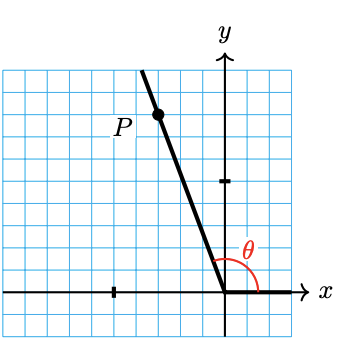
5. 
6. 
For Problems 7–10,
a Find the sine and cosine of the angle.
b Sketch the supplement of the angle in standard position. (Use congruent triangles.)
c Find the sine and cosine of the supplement.
d Find the angle and its supplement, rounded to the nearest degree.
7. 
8. 
9. 
10. 
For Problems 11–20,
a Sketch an angle in standard position with the given properties.
b Find cosθ,sinθ, and tanθ.
c Find the angle θ, rounded to tenths of a degree.
11. The point (−5, 12) is on the terminal side.

12. The point (12, 9) is on the terminal side.

13. cosθ=−0.8

14. cosθ=513

15. cosθ=311

16. cosθ=−56

17. tanθ=−16

18. tanθ=95

19. \tan \theta = 4

20. \tan \theta = -1

21. Fill in exact values from memory without using a calculator.
| \theta | 0^{\circ} | 30^{\circ} | 45^{\circ} | 60^{\circ} | 90^{\circ} | 120^{\circ} | 135^{\circ} | 150^{\circ} | 180^{\circ} |
| \cos \theta | |||||||||
| \sin \theta | |||||||||
| \tan \theta |
22. Use your calculator to fill in the table. Round values to four decimal places.
| \theta | 15^{\circ} | 25^{\circ} | 65^{\circ} | 75^{\circ} | 105^{\circ} | 115^{\circ} | 155^{\circ} | 165^{\circ} |
| \cos \theta | ||||||||
| \sin \theta | ||||||||
| \tan \theta |
23. For each angle \theta in the table for Problem 22, the angle 180^{\circ} − \theta is also in the table.
a What is true about \sin \theta and \sin(180^{\circ} − \theta)?
b What is true about \cos \theta and \cos(180^{\circ} − \theta)?
c What is true about \tan \theta and \tan(180^{\circ} − \theta)?
For Problems 25–28,
a Evaluate each pair of angles to the nearest 0.1^{\circ}, and show that they are supplements.
b Sketch both angles.
c Find the sine of each angle.
25. \theta=\cos ^{-1}\left(\dfrac{3}{4}\right), \phi=\cos ^{-1}\left(\dfrac{-3}{4}\right)
26. \theta=\cos ^{-1}\left(\dfrac{1}{5}\right), \phi=\cos ^{-1}\left(\dfrac{-1}{5}\right)
27. \theta=\cos ^{-1}(0.1525), \quad \phi=\cos ^{-1}(-0.1525)
28. \theta=\cos ^{-1}(0.6825), \quad \phi=\cos ^{-1}(-0.6825)
For Problems 29-34, find two different angles that satisfy the equation. Round to the nearest 0.1^{\circ}.
29. \sin \theta=0.7
30. \sin \theta=0.1
31. \dfrac{\sin \theta}{6}=0.14
32. \dfrac{5}{\sin \theta}=6
33. 4.8=\dfrac{3.2}{\sin \theta}
34. 1.5=\dfrac{\sin \theta}{0.3}
For Problems 35–38, fill in the blanks with complements or supplements.
35. If \sin 57^{\circ}=q, then \sin _______ =q also, \cos _______ =q, and \cos _______ =q.
36. If \sin 18^{\circ} = 2, then \sin _______ = w also, \cos _______ = w, and \cos _______ = -w.
37. If \cos 74^{\circ}=m, then \cos _______ =-m, and \sin _______ and \sin _______ both equal m.
38. If \cos 36^{\circ} = t, then \cos _______ = -t, and \sin _______ and \sin _______ both equal t.
39.
a Sketch the line y = \dfrac{3}{4} x.
b Find two points on the line with positive x-coordinates.
c The line y = \dfrac{3}{4} x makes an angle with the positive x-axis. What is that angle?
d Repeat parts (a) through (c) for the line y = \dfrac{-3}{4} x, except find two points with negative x-coordinates.
40.
a Sketch the line y = \dfrac{5}{3} x.
b Find two points o the line with positive x-coordinates.
c The line y = \dfrac{5}{3} x makes an angle with the positive x-axis. What is that angle?
d Repeat parts (a) through (c) for the line y = \dfrac{-5}{3} x, except find two points with negative x-coordinates.
For Problems 41-44,
a Find exact values for the base and height of the triangle.
b Compute an exact value for the area of the triangle.
41. 
42. 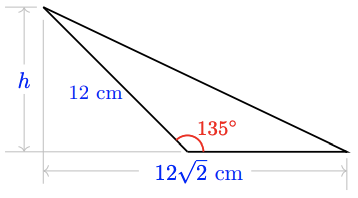
43. 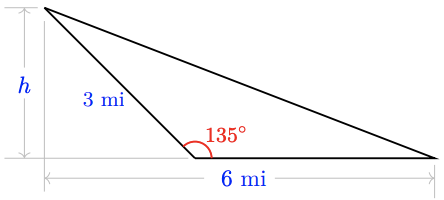
44. 
45. Sketch an angle of 120^{circ} in standard position. Find the missing coordinates of the points on the terminal side.
a (-1, ?)
b (?, 3)
46. Sketch an angle of 150^{\circ} in standard position. Find the missing coordinates of the points on the terminal side.
a (?,2)
b (-4,?)
47. Sketch an angle of 135^{\circ} in standard position. Find the missing coordinates of the points on the terminal side.
a (?,3)
b (-\sqrt{5}, ?)
48.
a Use a sketch to explain why \cos 90^{\circ} = 0.
b Use a sketch to explain why \cos 180^{\circ}=1.
For Problems 49-54, find the area of the triangle with the given properties. Round your answer to two decimal places.
49. 
50. 
51. 
52. 
53. b=2.5 in, c=7.6 in, A=138^{\circ}
54. a=0.8 \mathrm{~m}, c=0.15 \mathrm{~m}, B=15^{\circ}
55. Find the area of the regular pentagon shown below. (Hint: The pentagon can be divided into five congruent triangles.)

56. Find the area of the regular hexagon shown below. (Hint: The hexagon can be divided into six congruent triangles.)

For Problems 57 and 58, lots from a housing development have been subdivided into triangles. Find the total area of each lot by computing and adding the areas of each triangle.
57. 
58. 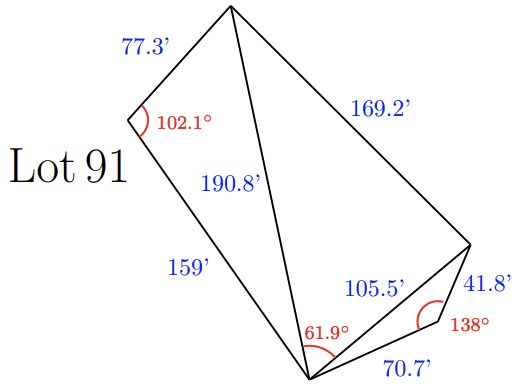
For Problems 59 and 60,
a Find the coordinates of point P. Round to two decimal places.
b Find the sides B C and P C of \triangle P C B.
c Find side P B.
59. 
60. 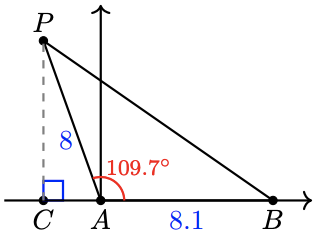
61. Later we will be able to show that \sin 18^{\circ}=\dfrac{\sqrt{5}-1}{4}. What is the exact value of \sin 162^{\circ}? (Hint: Sketch both angles in standard position.)
62. Later we will be able to show that \cos 36^{\circ}=\dfrac{\sqrt{5}+1}{4}. What is the exact value of \cos 144^{\circ}? (Hint: Sketch both angles in standard position.)
63. Alice wants an obtuse angle \theta that satisfies \sin \theta=0.3. Bob presses some buttons on his calculator and reports that \theta=17.46^{\circ}. Explain Bob's error and give a correct approximation of \theta accurate to two decimal places.
64. Yaneli finds that the angle \theta opposite the longest side of a triangle satisfies \sin \theta=0.8. Zelda reports that \theta=53.13^{\circ}. Explain Zelda's error and give a correct approximation of \theta accurate to two decimal places.
For Problems 65–70,
a Sketch an angle \theta in standard position, 0^{\circ} \leq \theta \leq 180^{\circ}, with the given properties.
b Find expressions for \cos \theta, \sin \theta, and \tan \theta in terms of the given variable.
65. \cos \theta=\dfrac{x}{3}, x<0
66. \tan \theta=\dfrac{4}{\alpha}, \alpha<0
67. \theta is obtuse and \sin \theta=\dfrac{y}{2}
68. \theta is obtuse and \tan \theta=\dfrac{q}{-7}
69. \theta is obtuse and \tan \theta=m
70. \cos \theta=h



